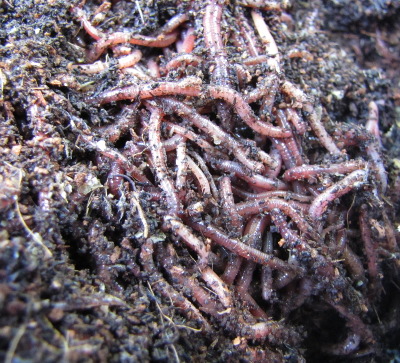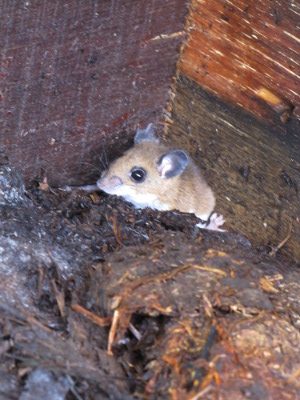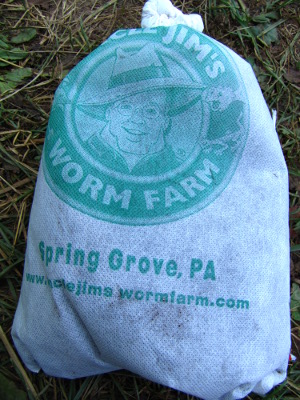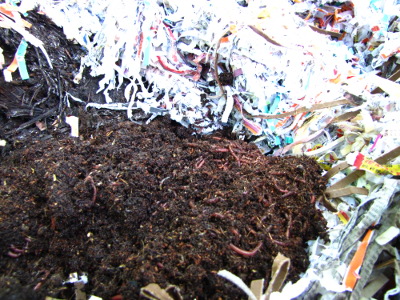
Seeding the new worm bin
 You
may recall that we've done several experiments with worm bins. In
2009, we had a small,
under-the-sink worm bin, which dwindled away because
we gave all of the worm-worthy scraps to the chickens, except for the
one thing chickens won't eat --- citrus peels. Unfortunately,
citrus peels also turned out to be the one fruit scrap that kills worms.
You
may recall that we've done several experiments with worm bins. In
2009, we had a small,
under-the-sink worm bin, which dwindled away because
we gave all of the worm-worthy scraps to the chickens, except for the
one thing chickens won't eat --- citrus peels. Unfortunately,
citrus peels also turned out to be the one fruit scrap that kills worms.
We started again last
year with an ambitious project of collecting food scraps from a local
school to feed a larger worm bin. That
project failed for various reasons, so we filled the bin back
up with horse manure and  bedding, which resulted in
some great
worm castings this
spring. (We got another ten buckets of castings between the time
I wrote that post and the time I'm writing this one.)
bedding, which resulted in
some great
worm castings this
spring. (We got another ten buckets of castings between the time
I wrote that post and the time I'm writing this one.)
But, once again, I made
some mistakes. We located our large worm bin out by the parking
area --- perhaps a third of a mile from our core homestead --- because
we wanted to be able to put food scraps into it from the school even
when the driveway was impassable. In permaculture terms, I think
of the parking area as zone 3 or 4, and a worm bin is more of a zone 1
or 2 project. Worms don't need as much care as your chickens or
vegetables, but good vermiculturists probably open the lid at least
once a week.
The result of placing
the bin so far from home is that it got neglected. I should have
refilled the bin early this spring with fresh manure, which would have
tempted the worms to reproduce and expand from their small winter
population. Instead, they were looking for food in their own
waste, and the number of worms dwindled yet further. There were
still enough  worms present to seed the new
manure we added to the bin a couple of weeks ago, but not enough worms
to move some to our new
Cadillac worm bin.
worms present to seed the new
manure we added to the bin a couple of weeks ago, but not enough worms
to move some to our new
Cadillac worm bin.
So we bought more
worms. We'd lost the contact information for our
local supplier, so
settled on buying two pounds of worm castings online. That's not
nearly enough worms for such a huge bin, but I don't really need the
castings until next spring, so I figure they've got plenty of time to
fill the space. I also added some soaked, shredded paper since
the horse manure smelled a bit like ammonia, a sign that it doesn't
have enough carbon and is outgassing precious nitrogen into the air.
(I also figured the paper would give the worms a safe place to hide if
the relatively fresh manure gets too hot for them.)
Meanwhile, Mark talked
me into building more worm bins (with the number yet to be determined)
as a way of stockpiling compost so that it improves with age. We
never  know when we'll be able to
drive biomass in and when we won't, so it's a good idea to work ahead,
but it's just sad to see last year's manure piles sink into the ground
before they can feed the garden.
know when we'll be able to
drive biomass in and when we won't, so it's a good idea to work ahead,
but it's just sad to see last year's manure piles sink into the ground
before they can feed the garden.
Even Mark blanched,
though, when I told him it would take at least ten big worm bins to
ensure I had enough compost for a solid year. Maybe we'll just
build another one or two for now....
Want more in-depth information? Browse through our books.
Or explore more posts by date or by subject.
About us: Anna Hess and Mark Hamilton spent over a decade living self-sufficiently in the mountains of Virginia before moving north to start over from scratch in the foothills of Ohio. They've experimented with permaculture, no-till gardening, trailersteading, home-based microbusinesses and much more, writing about their adventures in both blogs and books.
Want to be notified when new comments are posted on this page? Click on the RSS button after you add a comment to subscribe to the comment feed, or simply check the box beside "email replies to me" while writing your comment.

Dont worry about feeding house scraps to the worms. They can live off of newspaper. Trust me you can almost walk into any business around and ask for their old newspapers. I run mine through a paper shredder just for aesthetics. I also want to mention don't worry about feeding the worms only food scraps they need to work for you. Newspaper and water is all you need to keep your worms alive. I throw scraps in when I have them and thats it. The worms work on my schedule.
On the account of Uncle Jims I hope you recieved the right worms. I checked mine and I have three different breeds of redworms. One is a tropical worm (blue worm) and will die in an outdoor bin come winter time. I bought my second batch from Bentley at redwormcomposting.com and they have composted my newspaper and scraps ten times faster than the Uncle Jims batch.
Awesome blog keep up the good work!
Thomas --- Great info all around! I'm surprised to hear that worms can handle newspaper alone --- it seems that the high C:N ratio would make that decompose to a level they can consume very slowly. But it sounds like you've made it work. How long does it typically take your worms to eat their way through newspaper?
I should have peered at the worms more closely. They looked good on first glimpse, but they're deep in the pile now and unaccessible. I may try redwormcomposting.com for my next batch, since I will need to seed those next two bins...